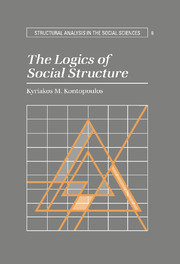Book contents
- Frontmatter
- Contents
- Preface
- Introduction
- Part I Metatheoretical considerations
- Part II Compositionist logics
- Part III Logics of hierarchy
- Part IV Heteracrchical logics
- Part V The phenomenology of social structures
- 12 Modalities and systems of interaction
- 13 Heterarchical levels of social structure
- 14 On structural totalities
- 15 In conclusion
- Appendix: The logics of structuration
- Glossary
- Bibliography
- Index
13 - Heterarchical levels of social structure
Published online by Cambridge University Press: 24 October 2009
- Frontmatter
- Contents
- Preface
- Introduction
- Part I Metatheoretical considerations
- Part II Compositionist logics
- Part III Logics of hierarchy
- Part IV Heteracrchical logics
- Part V The phenomenology of social structures
- 12 Modalities and systems of interaction
- 13 Heterarchical levels of social structure
- 14 On structural totalities
- 15 In conclusion
- Appendix: The logics of structuration
- Glossary
- Bibliography
- Index
Summary
A theory of structures is, by necessity, a theory of levels. Different levels of structural analysis imply different units of analysis, which in an ascending order become dynamically different (in scale), larger (in size), and more complex (in information or entropic complexity). As we have already said, however, the relation between these units is not one of complete inclusion and supersession as one would expect in a hierarchical organization – something more complex takes place here, as the levels interrelate to each other in an “entangled” way.
We have suggested in the previous part that a distinction should be made between local, quasi-local, quasi-global, and global levels of organization. In the social world, we usually identify the local level as the interpersonal one, the level of “interpersonal interactions.” Here is, for example, the locus of Boudon's various (functional, directly interdependent, and indirectly interdependent) “systems of interaction” which most often give rise to aggregated emergent effects. A variety of incipient structures always emerge at this level from the specific modalities and contingencies of interaction implicated; this is especially obvious, for example, in the case of systems of direct interdependence, organized by relevant elementary micrologics, such as the game-theoretical micrologics or the formal micrologics of coalition formation in triads. I call these “incipient structures” because they (a) involve rudimentary structuration (as in sociometric choices), (b) are quite often ephemeral (i.e., have a fast dynamic of emergence and extinction), and therefore (c) are not “institutionalized,” at least not yet at this level.
- Type
- Chapter
- Information
- The Logics of Social Structure , pp. 287 - 303Publisher: Cambridge University PressPrint publication year: 1993



